Radiant Systems Warm Rite Floor
Benefits of Pex-Al-Pex Tubing
- Easy to work with: can be laid by hand without the use of tools. Stays where it's put, no springing back.
- Greater heat transfer: aluminum is a better conductor then plastic
- 100% oxygen tight: No need to worry about oxygen penetration into heating systems
- Small heat expansion, similar to copper
- Flexible: because of the flexibility, up to 55% fewer fittings are needed
- Can be located with a metal detector, a must for attaching the floor after the project is completed (remodeling, adding walls in basements, bolting down a piece of equipment in a shop, etc.)
- Corrosion free: will not be affected by oil, etc. spilled on shop floors.
Advantages
- Ideal heat distribution: warm at the floor and coolest near the ceiling
- Energy efficient: save up to 30% over forced air. Set the thermostat 6-8 degrees lower and still be comfortable
- Clean: less dust movement
- Comfortable: even temperatures, no drafts or cold spots. Does not take humidity out of the air
- Quiet: no fans or blowers
- Convenient: no restrictions on placements of furniture
- Versatile: can be used in basement floors, sub-floors, shops, etc.
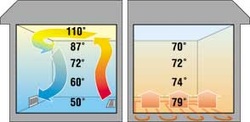
The upside down logic of forced air. In homes with forced air heating systems, most of the warmth collects at the ceiling. As the air cools, it migrates down to the floor. This "ceiling down" condition creates a "cold feet/hot head" layering effect that is neither comfortable nor efficient.
Warm Rite Floor delivers "floor up" warmth that makes sense. With a Warm Rite Floor radiant heating system, the entire floor is one even temperature surface that is constantly radiating warmth to every object in the room. Heat is continuously absorbed, so body temperature remains constant. Air stays humid and fells comfortable because it isn't being dried out by a forced air furnace. Homes built with a Warm Rite Floor system typically consume 10% to 30% less energy.
Here's Why:
Warm Rite Floor delivers "floor up" warmth that makes sense. With a Warm Rite Floor radiant heating system, the entire floor is one even temperature surface that is constantly radiating warmth to every object in the room. Heat is continuously absorbed, so body temperature remains constant. Air stays humid and fells comfortable because it isn't being dried out by a forced air furnace. Homes built with a Warm Rite Floor system typically consume 10% to 30% less energy.
Here's Why:
- Lower indoor air temperatures can be maintained for equal home comfort.
- Low temperatures above head level cause reduced loss through the ceiling.
- Less indoor air movement and layering means lower heat loss through the walls
- Heat loss due to air filtration and drafts is reduced.
Installations:
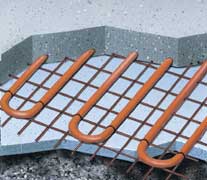
Concrete on grade with insulation
Install 1" -2" of Styrofoam board insulation on grade. Then lay down wire mesh and attach the pipe to it. pour concrete on top
Install 1" -2" of Styrofoam board insulation on grade. Then lay down wire mesh and attach the pipe to it. pour concrete on top
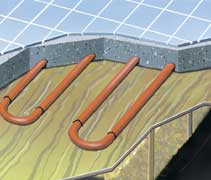
Topping pour on suspended floor
Attach pipe directly to the top of the wooden subfloor. Fill the cavity between the floor joints under the subfloor with regular batt insulation, ensuring there is no air gap. Embed pipe in a 1" to 1 1/2" layer of lightweight concrete. Excellent for ceramic tile floors!
Attach pipe directly to the top of the wooden subfloor. Fill the cavity between the floor joints under the subfloor with regular batt insulation, ensuring there is no air gap. Embed pipe in a 1" to 1 1/2" layer of lightweight concrete. Excellent for ceramic tile floors!
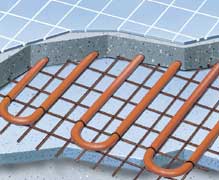
Concrete on grade with insulation
Install 1" to 2" of Styrofoam board insulation on grade. Then lay down wire mesh and attach pipe to it. Pour concrete on top
Install 1" to 2" of Styrofoam board insulation on grade. Then lay down wire mesh and attach pipe to it. Pour concrete on top
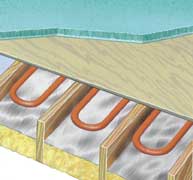
Concrete on grade with insulation
Lay down a 1" to 2" layer of Styrofoam board insulation. Install pipe directly on Styrofoam board. Embed pipe in a 1" to 1 1/2" layer of concrete. Excellent for retrofitting basements!
Lay down a 1" to 2" layer of Styrofoam board insulation. Install pipe directly on Styrofoam board. Embed pipe in a 1" to 1 1/2" layer of concrete. Excellent for retrofitting basements!
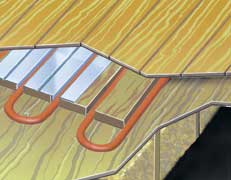
Sleeper system, with sub-floor under pipe
Install pipe at right angles to the floor joists directly on top of the sub-floor. Between the lengths of pipe install continuous lengths of strapping, or sleepers, to bear the weight of the next sub-floor. Fill the cavity between the floor joists under the sub-floor with regular batt insulation, ensuring there is no air gap. This system can be used with or without heat transfer piston.
Install pipe at right angles to the floor joists directly on top of the sub-floor. Between the lengths of pipe install continuous lengths of strapping, or sleepers, to bear the weight of the next sub-floor. Fill the cavity between the floor joists under the sub-floor with regular batt insulation, ensuring there is no air gap. This system can be used with or without heat transfer piston.
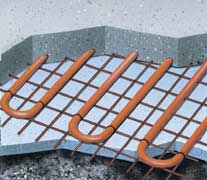
Under driveways and walks
The pipe can be embedded in concrete or installed in sand under asphalt for exterior snow melt applications. A layer of insulation should be installed under the pipe for added efficiency, and glycol must be added to the water to protect against freeze up. NOTE: Do not use auto antifreeze as it will foul metal components and ruin pump seals!
The pipe can be embedded in concrete or installed in sand under asphalt for exterior snow melt applications. A layer of insulation should be installed under the pipe for added efficiency, and glycol must be added to the water to protect against freeze up. NOTE: Do not use auto antifreeze as it will foul metal components and ruin pump seals!